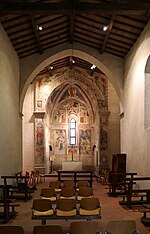Collodi (Italy)
PistoiaPopulated places in TuscanyProvince of Pistoia geography stubs

Collodi is a part of the municipality of Pescia in the Tuscany region of central Italy. It is a medieval village documented since the 12th century. It is known for its link to Carlo Lorenzini, who used the pen name Carlo Collodi and wrote The Adventures of Pinocchio. The writer, who was born in Florence and lived most of his life there, spent part of his childhood in the village and adopted its name for his literary career.The village has an ancient fortress and the aristocratic Villa Garzoni, which has a major garden. The economy of the village is based on tourism, thanks largely to a park dedicated to Pinocchio.
Excerpt from the Wikipedia article Collodi (Italy) (License: CC BY-SA 3.0, Authors, Images).Collodi (Italy)
Via di San Gennaro,
Geographical coordinates (GPS) Address Phone number Website Nearby Places Show on map
Geographical coordinates (GPS)
| Latitude | Longitude |
|---|---|
| N 43.9 ° | E 10.652777777778 ° |
Address
Parco di Pinocchio
Via di San Gennaro 21
51012
Tuscany, Italy
Open on Google Maps










